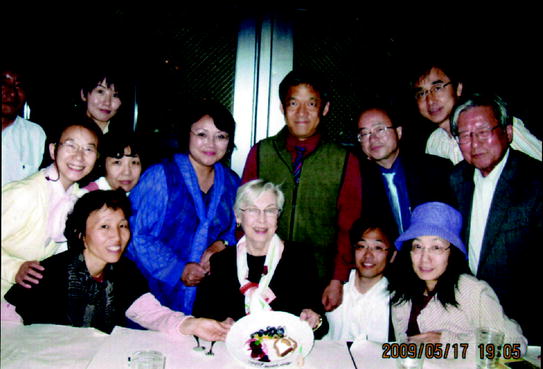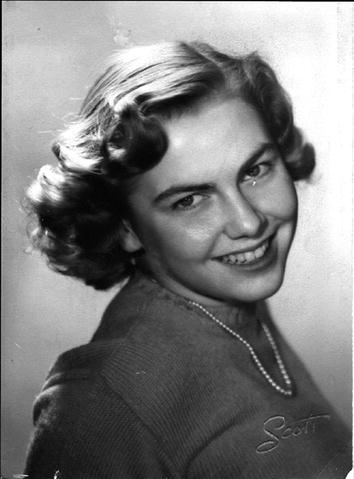Professional Biography of the Author: A Life in Peace Learning

Showing second grade art work with life-long friend Peggy Park 1938. Source Personal photo collection of the author
A number of the teachers who taught me and my peers also had taught our parents. It was in most respects a community, but it also reflected the social strata of the society with residents in estates and up-scale housing areas, middle class business and trades people, house workers and laboring people, largely recent Italian immigrants and a very few African American families among the latter. The public schools served mainly the middle and working classes. We were taught the basic learning skills, a bit of American history that included some Native American culture, but nothing about the fate of those peoples at the hands of our European ancestors. We learned that the slaves had been freed by Abraham Lincoln, but nothing about the lot of the slaves’ descendants in our own time. We also learned about the “right of revolution,” the Declaration of Independence and the Bill of Rights, the first ten amendments of the US Constitution. Whether it was intended as an affective learning objective or not, I internalized “the self-evident truths” and took their realization to be the work of my society. At the same time, young as we were, through subtle and sometimes blatant messages in our environment we became aware of the class and race differences and intuited their importance to our lives, and, as I continued to learn, the impediments they raised to the self-evident truths.
I attended high school in Rye, as well, where I began to have some intentional education on issues of social and economic justice that shed greater light on American racial injustice. Of the many fine teachers who introduced me to foreign languages, history, the sciences and made a noble but benighted attempt at teaching me math, one who had the greatest effect on the development of my social consciousness and world awareness was Frances Hamilton in a class that was called something like “Modern Problems” or “American Issues.” What mattered was her introduction to critical thinking and to the United Nation where some of us students accompanied her, sitting among the NGOs as early as its first days in 1946 and 1947 in Flushing Meadows before the world organization was installed in the “big glass house on the East River.”

1942 Rye Grammar School Graduation Class, Betty is in second row, second from left. Source Personal photo collection of the author
Another significant formative aspect of my childhood and adolescence was World War II that our family became more acutely aware of somewhat earlier than other American families because of my father being in the military. This fact was a worry shared by all my family, but the others in the family were not so convinced as I, first from the perspective of a 10 year old, at what I thought of as “the stupidity” of war. Surely, I thought there had to be another way to deal with the problems. I still do. Such thinking led me to become interested as a teen-ager in the United Nations and the newly forming movement of world federalism which seemed to my young mind to be an imminently sensible idea.
Our mother, a housewife and community activist instructed us in what we might now call “counter culture,” to the prevailing norms, assuring us that race and class differences were not what determined human worth, that all should be treated fairly and with respect. She was a no-nonsense parent, but we knew without a doubt that we had her unconditional love. Our father, an army officer and a criminal investigator who served several times with other branches of government, gave us the notion that we should behave with dignity and responsibility. He was often sorely disappointed in our response to these instructions, but always loving and delighted by us. He also instructed me in his own counter culture message that, gender notwithstanding, I could be and do whatever I hoped for. I do wonder if the message would have been the same, had he had a son. It was his expectation, not one for most middle class girls of the time, that we should receive higher education. With some significant sacrifice from my parents—mainly my mother who did the managing and worrying over money in those days following the Great Depression and the Second World War, that I began undergraduate education.

High school year book graduation portrait, 1947. Source Personal photo collection of the author
I graduated in 1951 with a BA in history from Wheaton College, one of the “Heavenly Seven” undergraduate colleges for women in New England that educated the daughters of the elite and a few of the bright young scholarship students of other classes. In this very WASP environment there was one Chinese student from Hong Kong, only a few Jewish and Catholic students, one African American student, and some African American maids who cleaned the dormitories. My on-going lessons on race and class and now ethnicity (and only much later, on reflection, gender) were imbedded with the fine academic education we young women were offered, as we were told in our freshman orientation, to prepare us to be suitable wives for successful men. I learned much at Wheaton and am still a ‘loyal’ if aware alumna who is glad to say that the college now welcomes many scholarship students of all ethnic backgrounds and both men and women students of all classes from many countries.
Although I had thought of teaching as the ‘work,’ women graduates expected to be an interim short pre-marriage career, I opted instead to find some type of professional work in New York City, for though I knew it well, New York still had the attractions of big cities that lured the young from the suburbs and the country-side. I tried for work in publishing and what was then called “race relations”—some few years later to blossom into the civil rights movement. Foiled by lack of typing skills, through the next 3 years I occupied my days at the Rockefeller Foundation summarizing and devising categories for ‘declinations,’ i.e. refused grant requests. Working in “the files” with other recently graduated young white women, our work delivered to our desk by equally educated young black men, provided further learning about social stratification by gender and race. (Years later I was to return to the foundation offices to discuss a writing assignment on arms spending and found that some of the young men had risen above the level of delivering the files. All the young women were long gone.) While I enjoyed socializing with my peers during lunch hours, and certainly reveled in what city evenings offered in entertainment and meeting young men, I felt a deep need to do something with my days that might serve my evolving social and political values, and address issues such as those that had led me earlier to seek work in promoting racial justice.
Goaded by friends I took up teaching and spent the first year teaching at an elite girls boarding school, Miss Halls in New England, and the next 9 years on the faculty of the Rye Country Day School, another private school, teaching history and social issues to middle or “junior high school” students ages 12–15. I found teaching challenging, rewarding and full of joy. Making direct connections with young and curious minds and coaxing the not so curious to find something relevant that would interest them in learning was a very rewarding way to spend my days. I certainly had failures in any number of my efforts, but on the whole I found satisfaction as I began the learning about learning and the development of the citizen that was to become the core of my life’s work in what some years later I came to identify as peace education.